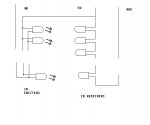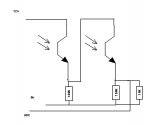bfgstew
Senior Member
Good morning all,
I could do with some help on this barrier idea of mine please.
The concept is a barrier using I/R emitters to I/R photodiodes, now the barrier is only 350mm x 250mm and is going to be used to catch small insects, birds etc in flight by breaking the beam which is connected to an ADC channel pin, trigger level is set via a pot and when ADC reaches level this it will cause an interupt and trigger my camera.
I have seen light barriers on the market like this but obvious cost implications involved!!!!
So my idea is using multiple (20)IR emitters on one side and receivers on the other to match. Now the 20 emitters is not a problem, the problem is the 20 receivers, well the final signal to the ADC pin is the problem. I have done a simulation on LIVEWIRE but with a phototransistor and with 20 in series the voltage drop is getting close to 3v and the reaction of the last receiver is poor not falling off until no light is on it. I need a good sweep on all receivers and sharp reactions from all of them.
A small diagram outlines my concept.

These are the http://www.bitsbox.co.uk/data/optos/tsus5400.pdfemitters and http://www.bitsbox.co.uk/data/bp10nf.pdfreceivers I am wanting to use.
Any ideas or changes to this idea would be gratefully received.
I could do with some help on this barrier idea of mine please.
The concept is a barrier using I/R emitters to I/R photodiodes, now the barrier is only 350mm x 250mm and is going to be used to catch small insects, birds etc in flight by breaking the beam which is connected to an ADC channel pin, trigger level is set via a pot and when ADC reaches level this it will cause an interupt and trigger my camera.
I have seen light barriers on the market like this but obvious cost implications involved!!!!
So my idea is using multiple (20)IR emitters on one side and receivers on the other to match. Now the 20 emitters is not a problem, the problem is the 20 receivers, well the final signal to the ADC pin is the problem. I have done a simulation on LIVEWIRE but with a phototransistor and with 20 in series the voltage drop is getting close to 3v and the reaction of the last receiver is poor not falling off until no light is on it. I need a good sweep on all receivers and sharp reactions from all of them.
A small diagram outlines my concept.

These are the http://www.bitsbox.co.uk/data/optos/tsus5400.pdfemitters and http://www.bitsbox.co.uk/data/bp10nf.pdfreceivers I am wanting to use.
Any ideas or changes to this idea would be gratefully received.


